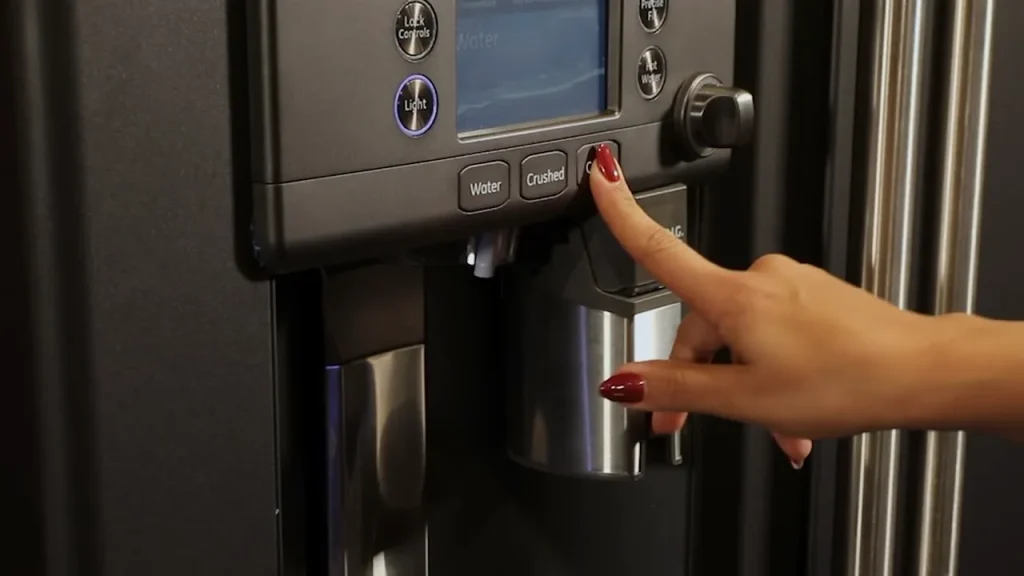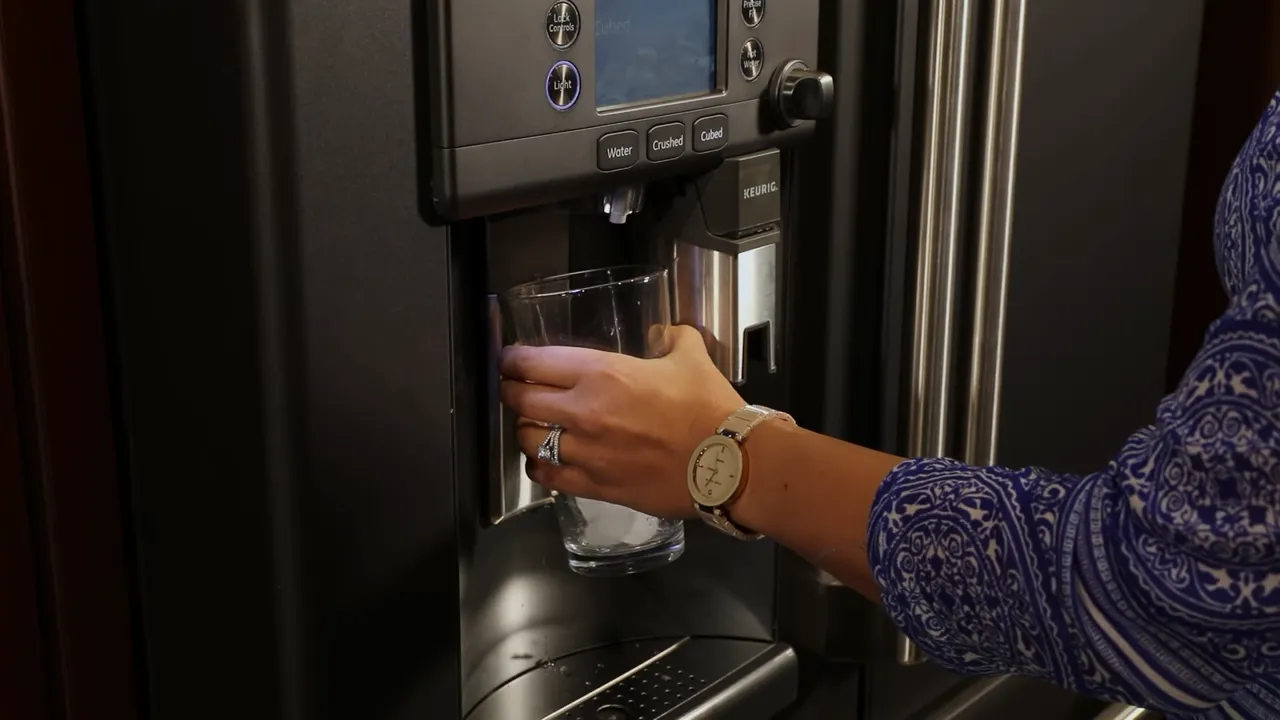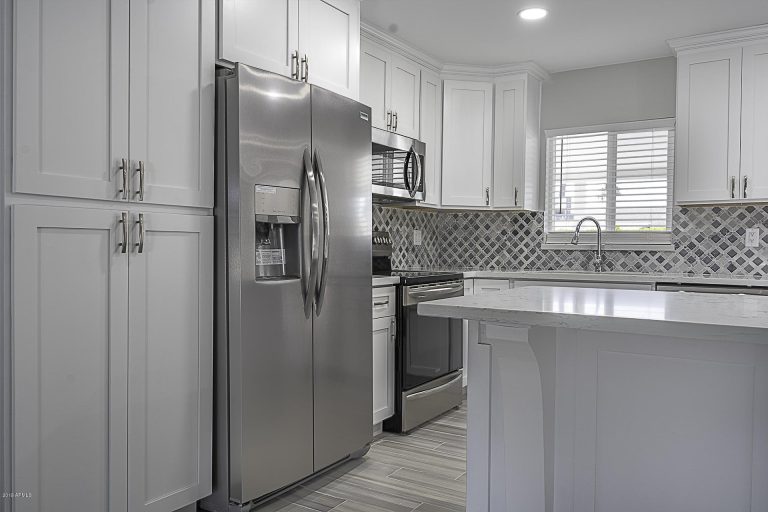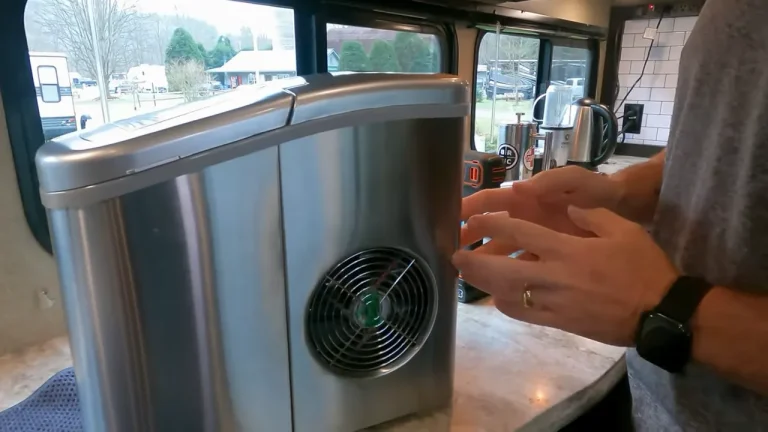GE Profile Refrigerator Ice Maker Troubleshooting (Guide 2024)
A well-functioning ice maker is a crucial component of any modern refrigerator, providing the convenience of ice on demand for refreshing beverages and preserving food. The GE Profile Refrigerator, known for its innovative features and advanced technology, is no exception.
Even the most reliable appliances may encounter issues from time to time. If you’ve found yourself facing challenges with your GE Profile Refrigerator’s ice maker, fret not – this article is designed to guide you through troubleshooting steps to identify and resolve common problems.
From understanding potential issues to implementing practical solutions, we will delve into the intricacies of troubleshooting your GE Profile Refrigerator’s ice maker, ensuring you can enjoy a steady supply of ice whenever you need it. Let’s embark on a journey to revive the functionality of your ice maker and keep your kitchen running smoothly.
Common Problems with GE Profile Refrigerator Ice Maker for Troubleshooting
1. No Ice Production
If your GE Profile Refrigerator’s ice maker is not producing any ice, it can be a frustrating issue. There are several potential causes for this problem.
Check the Power and Water Supply
Ensure that your refrigerator is properly connected to a power source and that the water supply is turned on. Sometimes, a loose power cord or a disconnected water line can be the culprit.
Verify the Ice Maker is Turned On
Confirm that the ice maker is activated. On many GE Profile Refrigerators, there is an on/off switch located on the ice maker itself. Make sure it is in the “on” position.
Inspect the Water Inlet Valve
Examine the water inlet valve to ensure it is not clogged or malfunctioning. A faulty valve can impede water flow to the ice maker. If you find any issues, consider replacing the valve.
Check the Water Filter
If your refrigerator has a water filter, it may be clogged. Replace the water filter following the manufacturer’s guidelines, usually recommended every six months.
Look for Ice Blockages
Inspect the ice maker for any ice blockages that might be hindering the production process. Clear any ice buildup that could be preventing the unit from functioning properly.
Ensure Proper Temperature Settings
Make sure that the freezer and refrigerator compartments are set to the recommended temperatures. The freezer should typically be set between 0 to 5 degrees Fahrenheit (-18 to -15 degrees Celsius) for optimal ice production.
2. Your GE Ice Maker Not Making Ice Fast Enough
If your GE Profile Refrigerator’s ice maker is not producing ice at the desired rate, there are several factors that could be contributing to the slower ice production.
Check the Ice Maker Settings
Ensure that the ice maker is set to its maximum ice production capacity. Some models have adjustable settings that allow you to increase the ice-making speed. Refer to your refrigerator’s user manual for instructions on adjusting these settings.
Verify Adequate Water Supply
Insufficient water supply can slow down ice production. Check that the water line is connected correctly, and there are no kinks or obstructions. Ensure the water pressure meets the recommended levels for optimal performance.
Inspect for Ice Blockages
Examine the ice maker for any accumulated ice or frost that might be impeding the ice ejection process. Clear away any obstructions to allow the ice maker to function smoothly.
Assess the Freezer Temperature
Ensure that the freezer compartment is set to the proper temperature. A freezer set too warm can hinder ice production. Aim for a temperature between 0 to 5 degrees Fahrenheit (-18 to -15 degrees Celsius) for optimal ice formation.
Check for Overcrowded Freezer
An overcrowded freezer can restrict air circulation and affect the ice maker’s performance. Rearrange items to allow proper airflow, facilitating faster ice production.
Inspect the Ice Bin
Ensure that the ice bin is not overfilled, as an excess amount of ice can hinder the ice maker’s ability to produce more. Empty the ice bin if necessary and make sure there are no obstructions.
Consider Ambient Temperature
The ambient temperature in your kitchen can impact the ice maker’s efficiency. If the room is too warm, it may take longer for the ice to freeze. Ensure that the kitchen temperature is within the recommended range.
Regular Maintenance
Keep your refrigerator and ice maker well-maintained by cleaning the condenser coils, checking the water filter, and following the manufacturer’s recommended maintenance procedures.
3. GE Profile Refrigerator Ice Maker Making Discolored Ice
If you’ve noticed that your GE Profile Refrigerator’s ice maker is producing discolored ice, it can be a cause for concern. The coloration may range from a slight tint to more noticeable discoloration.
Inspect the Water Supply
Discolored ice may be a result of impurities in the water supply. Check the water source connected to your refrigerator. If you have hard water or suspect contaminants, consider using a water filter designed for your refrigerator model.
Change the Water Filter
An old or clogged water filter can contribute to discolored ice. Follow the manufacturer’s recommendations for changing the water filter regularly. This can improve water quality and the overall taste and appearance of your ice.
Flush the Water System
If you’ve installed a new water filter or haven’t used the water dispenser for a while, flush the water system. Run a few cycles of water through the dispenser to clear out any air or residual impurities that might affect ice quality.
Inspect Ice Mold and Bin
Check the ice mold and bin for any residue or foreign substances that could be causing discoloration. Clean these components thoroughly with mild soap and warm water. Ensure there are no lingering odors or residues.
Avoid Storing Strong Odors in the Freezer
Strong-smelling foods in the freezer can transfer odors to the ice, affecting its taste and color. Store food in airtight containers to minimize odor transfer and regularly clean the freezer to prevent lingering smells.
Check for Mold or Mildew
Mold or mildew in the ice maker can lead to discolored ice. Inspect for any signs of mold or mildew and clean the ice maker accordingly. A mixture of vinegar and water can be an effective cleaning solution.
Assess Water Quality
If you’re using well water or water with high mineral content, consider installing a water softener or a water filtration system for the entire household to improve water quality.

4. Noisy GE Profile Refrigerator Ice Maker
If your GE Profile Refrigerator’s ice maker is producing unusual or excessive noise, it can be disruptive and cause concern. Noises may range from humming and clicking to more pronounced clattering sounds during the ice-making process.
Check Ice Maker Components
Inspect the various components of the ice maker for any loose or misplaced parts. Tighten screws and bolts as needed. Ensure that ice cubes are not obstructing any moving parts, causing excessive noise.
Leveling the Refrigerator
A refrigerator that is not level can lead to increased noise during the ice-making cycle. Use a level to check the refrigerator’s alignment and adjust the leveling feet as necessary to ensure proper balance.
Inspect Water Line Connections
Vibrations from the water line can contribute to noisy operation. Ensure that the water line supplying the refrigerator is correctly installed and secured. Adjustments or additional padding may be necessary to minimize vibrations.
Verify Ice Dispenser Arm Position
The ice dispenser arm can sometimes get dislodged or misaligned, leading to noise during operation. Check that the arm is properly positioned and not hitting the ice bin or other components.
Check for Ice Buildup
Ice buildup within the ice maker or surrounding components can lead to noisy operation. Thoroughly inspect and remove any accumulated ice or frost. Allow the ice maker to defrost and dry completely before restarting.
Evaluate Water Pressure
Inadequate water pressure can cause the water inlet valve to vibrate excessively, resulting in noise. Ensure that the water pressure is within the recommended range for your refrigerator and make adjustments if necessary.
Consider Ambient Temperature
Extreme temperatures in the kitchen or surrounding environment can impact the refrigerator’s performance and contribute to noise. Ensure the room temperature is within the manufacturer’s recommended range.
Regular Maintenance
Keep your refrigerator and ice maker well-maintained by cleaning condenser coils, checking for loose components, and ensuring proper alignment. Regular maintenance can prevent potential issues that may lead to noise.
5. Ice Maker Failing to Work After Filter Replacement
Problem: If your GE Profile Refrigerator’s ice maker has stopped working after replacing the water filter, it can be perplexing and frustrating. Several factors may contribute to this issue.
Proper Installation of the Water Filter
Ensure that the replacement water filter is installed correctly. Check the user manual for your refrigerator model to follow the manufacturer’s installation instructions. It’s crucial to align and insert the filter properly to ensure a secure fit.
Flush the Water System
After installing a new water filter, the water system may contain air or residual particles. Flush the water system by dispensing water through the water dispenser for several minutes. This helps eliminate any air bubbles and ensures the proper flow of water to the ice maker.
Check for a Bypass Plug
Some refrigerators have a bypass plug that should be used if you do not have a water filter installed. If you’ve replaced the filter with a bypass plug, confirm that it’s securely in place. Failure to use the bypass plug when not using a filter can prevent water flow to the ice maker.
Inspect for Obstructions
Examine the water line and connections for any kinks, bends, or obstructions. Ensure that the water line is not pinched, preventing the smooth flow of water to the ice maker.
Reset the Ice Maker
After replacing the water filter, reset the ice maker according to the manufacturer’s instructions. This may involve pressing a reset button or turning the ice maker off and then back on. Refer to the user manual for specific reset procedures.
Check Water Pressure
Inadequate water pressure can impact the ice maker’s performance. Verify that the water pressure meets the recommended levels for your refrigerator model. If the pressure is low, it might be necessary to adjust the water supply.
Inspect the Water Inlet Valve
The water inlet valve controls the flow of water to the ice maker. If the valve is faulty or clogged, it can impede water flow. Inspect the valve for any issues, and if necessary, consider replacing it.

How do I reset my GE refrigerator ice maker?
To reset your GE refrigerator ice maker, follow these general steps, but keep in mind that the specific instructions may vary slightly based on your refrigerator model. First, locate the control panel or settings on your refrigerator.
Some models have a dedicated button for resetting the ice maker, while others may require a combination of button presses. Refer to your refrigerator’s user manual for precise instructions, as it will provide model-specific guidance.
The reset process involves holding down a specific button or combination of buttons for a set duration. Once initiated, you might observe indicator lights or hear a beep, signaling that the ice maker has been successfully reset. After completing the reset, allow some time for the ice maker to resume its normal operation and start producing ice.
If you cannot find the reset instructions in the manual or encounter difficulties, contacting the manufacturer’s customer support can provide additional assistance tailored to your refrigerator model.
Why is my ice maker not making ice but water works?
If your ice maker is not producing ice while the water dispenser is still functioning, several common issues may be at play. One potential cause could be a clogged or frozen water line leading to the ice maker. Inspect the water line for any kinks, blockages, or ice buildup, and address these issues accordingly.
Check the water inlet valve, which controls the flow of water to the ice maker. A malfunctioning or faulty valve could restrict water access to the ice maker while still allowing water to reach the dispenser.
Ensure the ice maker is turned on, as some models have a separate switch or lever that activates or deactivates the ice-making function. Lastly, examine the ice maker unit for any visible malfunctions, such as jammed components or a full ice bin preventing further production.
If these troubleshooting steps do not resolve the issue, it may be necessary to consult the user manual for your specific refrigerator model or seek professional assistance to diagnose and address the problem.
Why is my GE ice maker not dispensing ice?
If your GE ice maker is not dispensing ice, several potential issues may be affecting its functionality. First, check the ice bin to ensure it is not overly full or blocked by clumped-up ice. Sometimes, ice can stick together, obstructing the dispenser.
Next, verify that the ice dispenser arm or paddle moves freely and is not obstructed. Inspect the auger, the component responsible for pushing ice through the dispenser, for any signs of damage or blockage.
Confirm that the freezer temperature is appropriately set, as an excessively low temperature might cause ice to stick together. If your refrigerator has a water filter, check if it is due for replacement, as an old or clogged filter can impede ice production and dispensing.
Finally, examine the water supply to the refrigerator, ensuring there are no kinks or blockages in the water line. If troubleshooting these common issues does not resolve the problem, it may be advisable to consult the refrigerator’s user manual or seek professional assistance to diagnose and address the specific issue with your GE ice maker.

What is the role of the icemaker fill tube heater?
The icemaker fill tube heater plays a crucial role in preventing the water fill tube of an ice maker from freezing. In refrigerators equipped with ice makers, water is supplied to the ice maker through a small tube.
In cold environments or when the freezer temperature is exceptionally low, the water in this tube may freeze, causing a blockage and hindering the ice-making process. The icemaker fill tube heater is designed to address this issue by generating a controlled amount of heat.
This heat prevents the water inside the fill tube from freezing, ensuring a continuous and unobstructed flow of water to the ice maker. By maintaining an open pathway for water, the fill tube heater contributes to the efficient and consistent production of ice, preventing disruptions that may occur due to freezing in colder conditions.
What can cause the ice level control board to malfunction?
Several factors can contribute to the malfunction of an ice level control board in a refrigerator. The ice level control board is a crucial component responsible for regulating the ice maker’s functions, including ice production and dispensing.
Common causes of malfunction include electrical issues such as power surges, voltage fluctuations, or even component wear and tear over time. Exposure to moisture or water damage can also compromise the integrity of the control board, leading to malfunctions.
Moreover, manufacturing defects or inherent weaknesses in the design of the control board can be contributing factors. In some cases, the malfunction may be a result of a failure in communication between the control board and other components within the ice maker system. Any disruption in this communication pathway can lead to erratic ice-making behavior or a complete failure to produce ice.
Regular maintenance, prompt repairs, and addressing issues like water leaks or electrical problems can help mitigate the risk of ice level control board malfunctions. If the control board does malfunction, replacement or professional repair may be necessary to restore the proper functionality of the ice maker.
What should I check if there is low water pressure coming into the refrigerator?
If you’re experiencing low water pressure coming into your refrigerator, several potential factors may be contributing to the issue. Start by checking the water supply valve connected to the refrigerator and ensure it is fully open. Verify that the water line itself is not kinked, pinched, or otherwise obstructed, as any impedance in the line can reduce water flow.
Inspect the water filter for clogs or obstructions. A dirty or old filter can significantly impede water pressure, so consider replacing it based on the manufacturer’s recommended schedule.
Examine the saddle valve, which connects the water line to the household water supply. These valves can become clogged or partially closed over time. If you find any issues, clean or replace the valve as needed.
Check for any leaks in the water line, as leaks can contribute to reduced water pressure. Additionally, if your refrigerator has a water pressure regulator, ensure that it is set to the proper pressure level.
FAQ:
Why is my GE Profile refrigerator ice maker not producing ice?
Several factors can contribute to this issue. Check the power supply, water connection, and ensure the ice maker is turned on. Inspect the water inlet valve and the water filter for clogs or malfunctions. If problems persist, refer to the troubleshooting section in your refrigerator’s user manual or seek professional assistance.
What should I do if my ice maker is producing discolored ice?
Discolored ice may indicate impurities or contaminants. Replace the water filter, flush the water system, and clean the ice mold and bin. If the issue persists, consider the water quality in your area or contact customer support for further guidance.
How do I increase the ice-making speed of my refrigerator’s ice maker?
Check the ice maker settings for maximum ice production. Ensure proper water supply, inspect for ice blockages, and maintain recommended freezer temperatures. If your refrigerator has adjustable settings, consult the user manual for instructions on optimizing ice-making speed.
Why is my ice maker making excessive noise?
Noisy operation could be due to loose components, an unlevel refrigerator, or vibrations from the water line. Check and tighten screws, level the refrigerator, and inspect the water line for secure connections. Regular maintenance can also minimize noise.
My ice maker stopped working after replacing the water filter. What should I do?
Ensure proper water filter installation, flush the water system, and check for a bypass plug if necessary. Confirm that the water line is not obstructed, and reset the ice maker according to the manufacturer’s instructions. Contact customer support if problems persist.
What is the role of the icemaker fill tube heater?
The icemaker fill tube heater prevents the water fill tube from freezing, ensuring a continuous water flow to the ice maker. It helps maintain optimal conditions for ice production, especially in cold environments or when the freezer temperature is low.
How do I reset my GE refrigerator ice maker?
Locate the control panel, follow the specific instructions in your user manual, and initiate the reset process. This often involves pressing a reset button or a combination of buttons for a set duration. After resetting, allow time for the ice maker to resume normal operation.
Why is my ice maker not dispensing ice, but the water dispenser is working?
Check for ice blockages, inspect the dispenser arm, and verify the auger’s condition. Ensure the freezer temperature is set correctly, and examine the water filter. If troubleshooting does not resolve the issue, consult the user manual or seek professional assistance.
What can cause the ice level control board to malfunction?
Electrical issues, exposure to moisture, manufacturing defects, and communication failures with other components are common causes of ice level control board malfunctions. Regular maintenance and addressing electrical or water-related issues can help prevent malfunctions.
What should I check if there is low water pressure coming into the refrigerator?
Inspect the water supply valve, check for kinks or obstructions in the water line, and examine the water filter for clogs. Ensure the saddle valve and water pressure regulator are functioning correctly. If issues persist, consult a professional plumber to assess the household water supply.
As an Amazon Associate I earn from qualifying purchases.
- Can You Put Clouds Shoes in the Washing Machine? With Tips & Tricks - April 10, 2024
- European Washing Machine vs American – History, Design, Technology - March 27, 2024
- Can You Put Boxing Gloves In The Washing Machine? – Expert Tips - March 25, 2024


![Kenmore Refrigerator Troubleshooting Not Cooling! [Quick Fix]](https://homeplacetips.com/wp-content/uploads/2023/12/Kenmore-Refrigerator-Not-Cooling-at-all-Compressor_000072308-768x432.webp)
![Bosch vs LG Refrigerator [Which One Should You Choose?]](https://homeplacetips.com/wp-content/uploads/2023/10/Bosch-Maxflex-332L-Refrigerator-🇮🇳-Best-Refrigerator-2023-⚡️-Best-3-Door-Refrigerator-2023_000056394-768x432.webp)
![GE Profile Refrigerator Troubleshooting Water Dispenser [2024]](https://homeplacetips.com/wp-content/uploads/2023/12/GE-Refrigerator-Repair-Door-Does-Not-Dispense-Water-Saddle-Tapping-Valve-Troubleshooting_000240869-768x432.webp)


![Brand New Fridge Making Noise [Easy Fix]](https://homeplacetips.com/wp-content/uploads/2024/01/LG-Refrigerators-Understanding-Noises-From-An-LG-Refrigerator_000074741-768x432.webp)